Shaping Scotland's economy: inward investment plan
Shaping Scotland’s Economy: Scotland’s Inward Investment Plan sets out our ambition for Scotland as a leading destination for inward investment aligned with our values as a nation.
6 Priorities: Scotland’s Strengths in A Global Context
6.1 Where Scotland’s Competitive and Comparative Advantage meets Global Opportunity
As we identified earlier in this report, Scotland has had good success to date in attracting inward investment. That success has generally been built on prioritising areas of greatest opportunity where there are significant inward investment deal flows into Europe. Typically these have been Software and IT, Business Services and Financial Services. Over 10,000 jobs have been created in Scotland in these sectors in the past three years and their overall deal flow into Europe remains high.[48]
Scotland has had good success to date in attracting inward investment
The chart shows how successful Scotland has been. While representing less than 1% of Europe’s population, Scotland has successfully attracted a relatively high proportion of European jobs and projects across a number of sectors.[49]
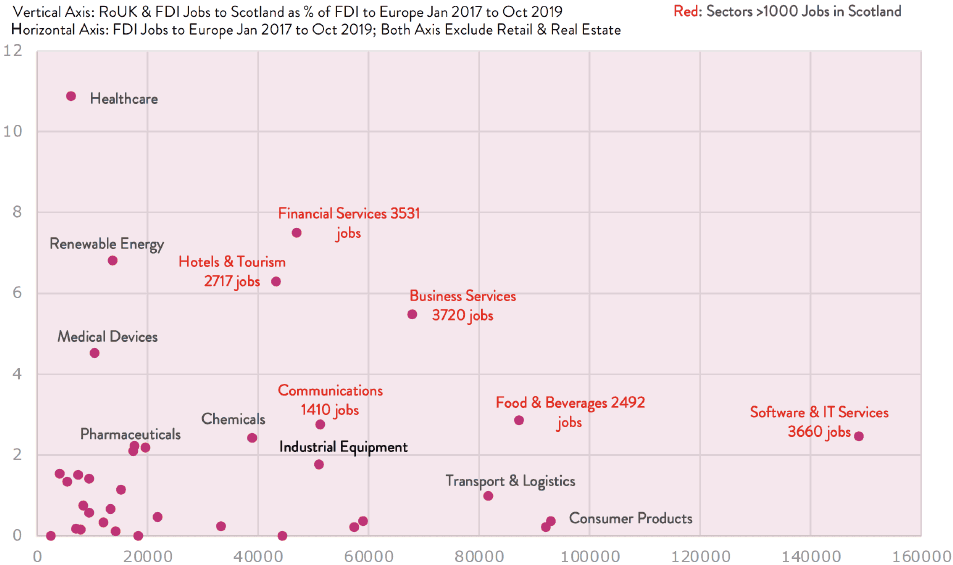
Source: SDI Analysis using data from fDi Markets, a service from The Financial Times Limited (2020). All Rights Reserved
However as we have identified, there is significant potential to deliver additional higher gains for Scostland’s economy by maximising the wider spillover benefits of inward investments.
6.2 Evidence-Informed Analysis set in the Context of our Values-Led Approach
The plan is based on a detailed programme of analysis. This analysis draws on more than 25 data sets including from Scottish Government statistics, Office for National Statistics, Scottish Development International, Financial Times fDi markets, EY, the Department for International Trade (DIT), OECD and NESTA which were interrogated to build our understanding of the impacts of investment on the economy, to identify our areas of current and future competitive and comparative advantage and to understand the types of projects likely to deliver the widest range of benefits. The plan also draws on the rich economic literature on fDi, including the emerging literature on assessing and targeting quality fDi.
To understand where our public sector efforts should be focused, we have analysed Scotland’s existing and emerging competitive advantages against global investment deal flows and assessed their potential fit with our values-led approach. We have developed an analytical approach that helps us to understand the potential wider economic impacts of projects in different sectors to guide decision making. We have also analysed the resilience of different sectors to the impacts of the Covid-19 pandemic.
This approach is data driven but is also informed by the economy that we want to create for Scotland. Therefore, while the data directs us towards opportunities for Scotland, we will only pursue these opportunities where they fit with our priorities and values.
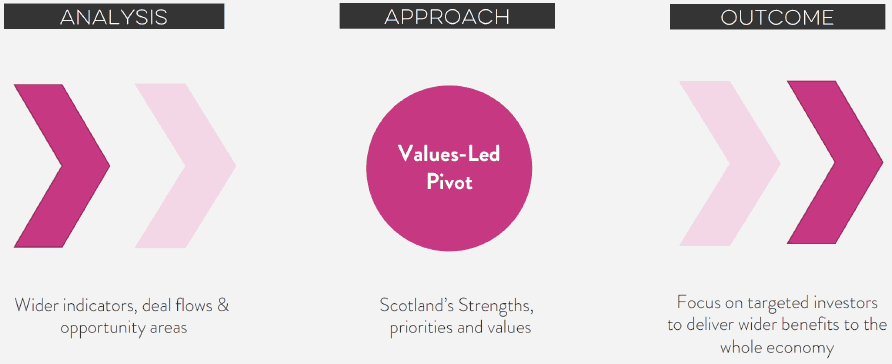
The analysis is driven by a wealth of data and analysis taken from a wide variety of sources to try to ascertain Scotland’s performance in different sectors and understand the future opportunities which will have the widest benefit to the Scottish economy. The analytical methodology is described in much greater detail in the Analytical Methodology note produced by the Office of the Chief Economic Adviser accompanying the release of this plan.
Our approach is data driven but is also informed by the economy that we want to create for Scotland
To understand Scotland’s performance and the size and future growth potential of different sectors the following data sources have been used:
Current performance and investment flows
- Financial Times fDi Markets data on project numbers, capital expenditure and jobs into Scotland[50]
- Financial Times fDi Markets data on project numbers, capital expenditure and jobs into Europe
Future Growth
- Financial Times fDi Markets time series data on fDi projects into Europe to predict growth
- EY survey of investors predicting growth sectors[51]
These data sources are used to produce a Revealed Comparative Advantage (RCA) index, highlighting the sectors in which Scotland has demonstrated strengths in attracting projects.
Detailed analysis has also been carried out to assess the potential wider economic impacts of projects and how they compare across sectors. As set out in Section 3.4, and backed up by an extensive economic literature on fDi, benefits from foreign companies can spill over to domestic businesses, leading to increases in productivity, wages, jobs and output. As part of the Plan, a detailed literature review has been carried out to understand the characteristics of projects that generate wider economic impacts. The key strands identified are as follows:
1. Supply chains – as well as the direct benefits of purchasing products and services from domestic business, the economic literature suggests that benefits from foreign-owned firms can spill over to domestic firms through supply chain developments. Firms have an incentive to transfer knowledge to their suppliers in order to improve the quality of their inputs. Additionally, downstream firms benefit from a greater variety and quality of inputs.
2. Innovation – the benefits from innovation and research and development spending can benefit other firms throughout the economy through knowledge spillovers and demonstration effects. In addition, employees of innovative inward investment firms may use the knowledge they have gained to start their own innovative companies.
3. Labour market – a well-functioning labour market helps to spread the benefits from inward investment firms through the movement of labour, with employees bringing skills and experience with them when they move job.
4. Agglomeration and cluster building – there are more opportunities for knowledge and good business practices to spill over to other firms when there are many similar firms in close proximity geographically.
5. Productivity – targeting inward investment firms that are world-class in their levels of productivity offers the potential for some of their practices and other ways of doing business to spill over to domestic firms.
6. Regional impacts – spillovers can often be local, so it is important to identify regional strengths, and the potential for local cluster building to attract inward investors into different regions of Scotland so that regional economies can also benefit.
These insights from the economic literature have been paired with a variety of data sources to create a series of wider economic impact indicators. These indicators show which sectors particularly demonstrate the characteristics described above and so help in the choice of the sectors to prioritise in order to achieve wider economic benefits from inward investment. These data sources include:
Supply chain impacts of inward investment
- Scottish Government Input Output Tables[52]
Evidence on the economic spillovers of inward investment
- Department for International Trade analysis[53]
- Detailed economic literature review
Innovation and R&D spending
- NESTA analysis on Scottish patents[54]
- Scottish Government statistics on business R&D in Scotland[55]
Wages and productivity
- Scottish Government statistics on average wages by sector[56]
- Scottish Government statistics on average gross value added per head by sector[57]
Regional impacts, natural capital and agglomeration
- Scottish Government statistics on the distribution of employment across Scotland, used to calculate location quotients[58]
- Scottish Government Urban Rural Classification[59]
- Scottish Government Natural Capital Accounts[60]
- Scottish Government labour market statistics[61]
- UK research on clusters[62]
As noted above, more detailed information on the methodology underlying the selection of future opportunities is contained in the Analytical Methodology note produced by the Office of the Chief Economic Adviser accompanying the release of this plan.
6.3 Identifying Scotland’s Opportunity Areas
As described above, the analysis identified the ‘points of intersection’ between Scotland’s specific global competitive strengths, major flows of inward investment, and the sectors and types of investment which typically yield greater spillover to the rest of the wider economy.
The chart alongside summarises this analysis. It highlights the sectors in which Scotland has a comparative advantage (vertical axis), the extent of wider positive impacts on the economy (horizontal axis) and the deal flow, or opportunity for growth in each sector (the size of the ‘bubble’). This analysis allows us to identify the sectors which offer the greatest opportunity for us to meet our objectives.
The quantitative evidence shown in the chart was also paired with qualitative evidence and sector expertise, and aligned with the values and priorities outlined in the National Performance Framework for Scotland.[63]
This analysis allows us to identify the sectors which offers the greatest opportunity for us to meet our objectives
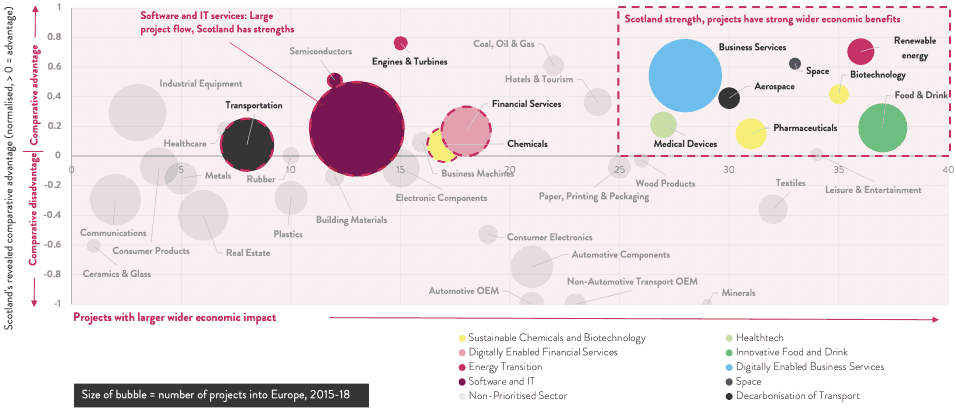
Source: Office of the Chief Economic Adviser Analysis using data from multiple sources. Please see the technical methodology note for more information.
The areas highlighted with red dotted lines show the sectors that the data identifies as priority sectors, or opportunity areas, for inward investment. Where bubbles are coloured, this shows that they are included in the prioritised opportunity areas. Greyed out sectors are not identified as priorities by this analysis.
Of the red dotted areas on the chart, the box in the upper right quadrant shows the sectors where Scotland performs strongly and that score highly against the wider economic impact score set out previously.
Some sectors indicated a potential in purely economic terms but did not match with our values and aspirations for Scotland’s economy.
Other sectors such as Software and IT services do not score as highly as some others on wider economic impacts, but Scotland has a comparative advantage in this area and there is a very large flow of projects into Europe (as evidenced by the size of the bubble). Other sectors (such as space) currently demonstrate a relatively small opportunity but this is expected to grow substantially as the sector matures. In other broad sectors, such as financial services, prioritisation is based on the future prospects for the sector in the area of digitally enabled financial services. The analysis also shows the rationale for choosing a number of future opportunities including healthtech and innovative food and drink.
Based on the analysis conducted a total of nine opportunity areas were identified as being a priority for Scotland’s inward investment activities.
These nine opportunity areas are:
1. Energy transition
2. Decarbonisation of Transport
3. Software and IT
4. Digital Financial Services
5. Digital Business Services
6. Space
7. Healthtech
8. Transformation of Chemical Industries
9. Food & Drink Innovation
6.4 Covid Impact and Impetus
These opportunity areas have also been analysed to understand their resilience to the economic disruption caused by Covid-19. Independent research by market commentators such as Wavteq, OCO Global and EY suggest that the areas chosen here are also likely to be amongst the most resilient, with healthtech, digital, energy transition, software and IT and financial services amongst the sectors they identify as robust to the economic shock of Covid-19. The Renewable Energy sector for example announced major new offshore wind projects during the crisis. Niche sectors may also be subject to positive investment flows e.g. within Biotechology, E-Health, Food and Drink and Digital Technologies.
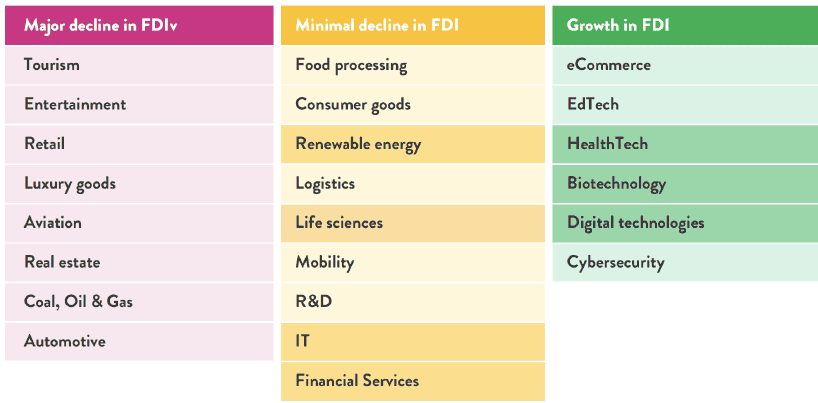
Source: Wavteq[64]
There remain, of course, considerable uncertainties around long-term impacts. Source geographies for inward investment are being impacted in different ways by the pandemic, and to different extents, and they will recover at different rates.
Scotland’s supply side proposition has also been altered through the pandemic. For example, Scotland’s university response to vaccination and treatment research, combined with company innovation and skills base has attracted new healthtech investment.
The crisis will motivate some inward investors to revise their supply chain and international presence. The shortening of industry value chains as a result of Covid-19 is underpinned by investors seeking to build in an element of resilience to ensure they are able to service their markets and customers effectively.
In some instances, companies will draw activity closer to their home markets. Other companies will set up multiple facilities to serve different world regions. Work with existing inward investors in Scotland is an important priority, to support operations and to encourage new expansion activity.
We also believe there will be a strong role for Scotland to play in a pivot to distributed working accelerated by Covid whereby companies rethink their corporate real estate footprint and engage a dispersed workforce located in particular geographic skills hubs.
The pandemic may also accelerate mindset shifts towards a net zero world, leading to enhanced sector opportunities. Inward investment projects linked to remote working may increase e.g. across digitally enabled industries.
With this level of uncertainty a degree of flex will be required in implementing the approach to be responsive to key market developments. The analysis that has underpinned the identification of our priorities will be maintained and refreshed. In an uncertain, volatile and fiercely competitive world, it is vital that Scotland continuously develops its distinctive strengths and comparative advantages, mixing and matching its strongest assets and capabilities to capitalise on new and emerging global opportunities.
This includes using our deep understanding of the key assets in each region and presenting these as strong investment options within the overall Scottish proposition to ensure that the benefits of inward investment can be felt throughout the country.
6.5 Scotland’s Opportunity Areas for Inward Investment
The nine opportunity areas identified broadly fall under three overarching areas for Scotland’s Economy of Net Zero, Digital and High Value Manufacturing, with several of the opportunity areas contributing to more than one of these priority themes.
Net Zero
Scotland is committed to becoming a net-zero society by 2045 – five years before the rest of the UK, and in line with the advice from the government’s independent expert advisors, the UK Committee on Climate Change[65]. Our targets for reductions in Greenhouse Gas emissions are contained in the Climate Change Act[66] (the levels of the Scottish targets are expressed as percentage reductions from the 1990/1995 baseline).
Delivering a green economic recovery, to respond to the Global Climate Emergency and impacts of Covid-19 is a priority for the Scottish Government as set out in the response to the Advisory Group on Economic Recovery led by Benny Higgins and forthcoming update to the Climate Change Plan. Meeting our targets will require a transition in the energy sector from using fossil-fuels to renewables as well as decarbonisation across a range of energy-intensive sectors, including transport.
Scotland is committed to becoming a net-zero society by 2045 – five years before the rest of the UK
Digital
With its strength as a destination for the tech industry, its vibrant start-up ecosystem and world-class universities Scotland has a competitive advantage in digital across a range of opportunity areas including: Software and IT; Financial Services (including fintech); and Business Services.
As acknowledged earlier in this Plan, the Covid-19 crisis has placed digital at the forefront of the response and subsequent recovery steps across the private, public and third sectors. There is now multi-lateral recognition of the need to consider new models of delivering public, private and third sector services. Across all sectors, including financial and business services, technology
is now a key enabler for delivering positive economic and social outcomes for people, communities and business alike.
The UK is ranked 2 in the Global Readiness for AI Index (OECD countries) and the Scottish Government in conjunction with The Data Lab and partners is developing an AI strategy for Scotland to ensure that we realise that potential.[67]
High Value Manufacturing
Manufacturing is vital to Scotland’s economy, employing more than 180,000 people across the country. It encompasses a broad range of sectors from food & drink and chemicals to life sciences and space. A large proportion of the jobs are highly skilled, with engineering, digital and commercial skills all important. These jobs are also also widely dispersed among the towns and cities of Scotland.
The opportunity is now to grow Scotland’s manufacturing sector, strengthen supply chain linkages and increase productivity using advanced manufacturing technologies such as automation, AI and digital manufacturing techniques. This is supported by a coordinated plan, Making Scotland’s Future, to build skills, innovation and leadership and secure increased investment.
The major asset underpinning these ambitions in high value manufacturing is the Advanced Manufacturing Innovation District Scotland (AMIDS). This will become an internationally recognised centre for innovation, research and manufacturing in Scotland’s industrial heartland.
Key elements of AMIDS are:
- The National Manufacturing Institute Scotland (NMIS) that will include the Manufacturing Skills Academy, as well as a fully digitalised factory of the future and collaboration hub for manufacturers of all sizes and from all sectors.
- The Advanced Forming Research Centre (AFRC), Scotland’s High Value Manufacturing Catapult centre focusing on research and development of manufacturing technologies, metal forming and forging research.
- The Lightweight Manufacturing Centre (LMC) to support innovation in the aerospace and automotive industries.
- The Medicines Manufacturing Innovation Centre, which will be the catalyst for development of advanced manufacturing in Scotland’s life sciences sector.
Scotland’s electricity system is now largely decarbonised – in 2019 more than 90% of Scotland’s electricity was generated from renewables
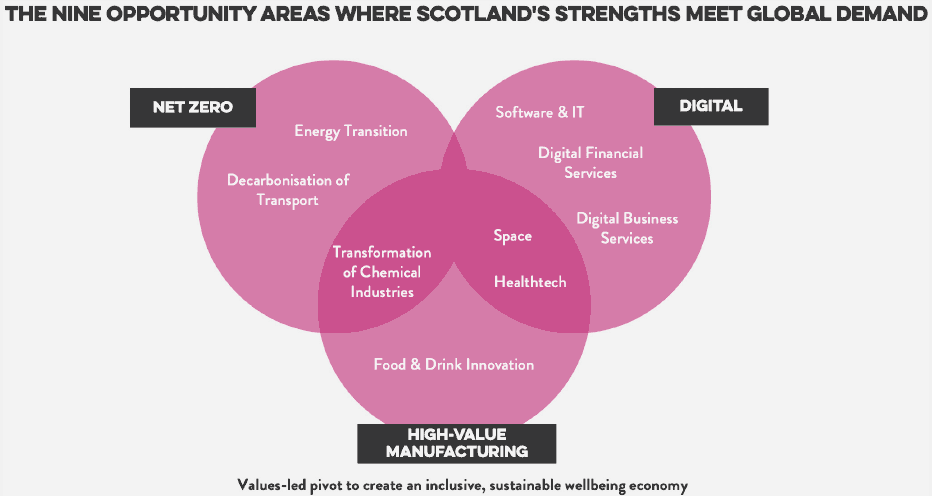
Opportunity Area 1: Energy Transition
We now examine each of these nine opportunity areas in terms of Scotland’s strengths, success and opportunities.
Energy transition is the shift in the global energy sector from using fossil-fuels like oil, gas and coal, to renewable energy sources like solar, wind and wave. It’s also about reducing carbon dioxide emissions across a range of energy-intensive sectors like heat, transport and some industrial processes, through various forms of decarbonisation.
While Scotland’s electricity system is now largely decarbonised – in 2019 more than 90% of Scotland’s electricity was generated from renewables - the ambition of a net zero, sustainable, carbon economy by 2045 means we will continue developing our existing strengths in renewable energy in areas like fixed-bottom and floating offshore wind, and emerging areas, such as tidal, wave, hydrogen, carbon capture and storage, and local energy systems.
A key element of the transition is the ongoing need for fossil fuels and the commitment of the oil and gas industry in Scotland to deliver a Net Zero Hydrocarbon Basin by 2050. This would be the first Net Zero Hydrocarbon basin in the world and is supported by the industry’s Roadmap 2035. This will require new technology and ways of working which may be attractive to companies looking to invest in Scotland.
Scotland is a highly attractive key location for investment in renewables. In terms of inward investment deal flow in renewable energy, Scotland has attracted 6.3% of the total projects that came into Europe and 6.4% of the jobs, over the last three years. Scotland has strong competitive advantages in several specific areas across the energy transition.
Offshore Wind: Scotland is already a global leader. This position is based on:
- natural assets – Scotland has 25% of Europe’s offshore wind resource.
- built assets – including excellent port infrastructure. An extensive list of the various ports and harbours used can be found on the offshore Scotland website at www.offshorewindscotland.org.uk.
- skills – with expertise built up in the offshore oil and gas industry and a number of universities which specialise including Offshore Renewable Energy Catapult (OREC) at Strathclyde University and the ORCA Hub (Offshore Robots for Certification of Assets) at Heriot Watt and Edinburgh Universities which uses robotics to research applications in offshore renewables.
- research and innovation – with excellent test and demonstration facilities.
Scotland is a highly attractive key location for investment in renewables
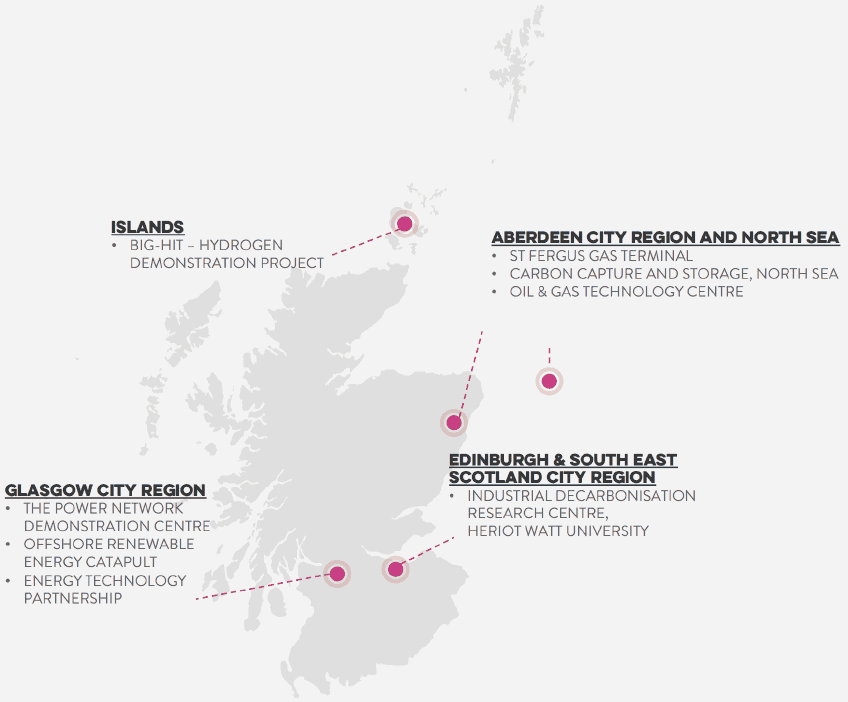
Hydrogen:
In the North East, Scotland has an emerging Hydrogen Coast, which runs from Orkney to Aberdeen and to Fife, with a number of new and existing projects. World-leading hydrogen demonstration projects, such as BIG-HIT in Orkney, test the integration of renewable energy to create hydrogen for power, heating and transport.
As a result of funding from the Scottish Government Energy Transition Fund, plans are underway to develop a Hydrogen Hub in Aberdeen which would present the opportunity to attract international investors to develop solutions to use green hydrogen in the transport sector. Our hydrogen inward investment priorities will also include attracting electrolyser manufacturers to Scotland.
Carbon Capture and Storage (CCS):
Scotland’s competitive advantage in CCS is based on the built and natural assets of the North Sea oil and gas industry and the great offshore engineering skills and experience of that workforce.
The St Fergus gas terminal in North East Scotland is being developed as a major site for both hydrogen production and CCS.
Local Energy Systems:
Scotland has key strengths in the enabling technologies (data analysis, software, sensors and power electronics) to manage the shift to smart, flexible local energy networks that can match power supply and demand.
The Power Network Demonstration Centre in Glasgow is a key asset in developing innovative solutions for energy systems.
Decarbonising heating and cooling:
Decarbonising heating and cooling could make a significant contribution to Scotland’s net zero ambitions. From 2024 all new homes built in Scotland (from 2025 elsewhere in the UK) must use renewable or low-carbon heating, which will create significant demand for heat pumps and therefore the opportunity to attract inward investment from leading international heat pump manufacturers and their supply chains.
The Oil and Gas Technology Centre (OGTC) based in Aberdeen and Offshore Renewable Energy Catapult (OREC) in Glasgow are two key Scottish based technology organisations, well connected not only in the UK but in many countries globally, and are unique offerings for many companies in addressing the energy transition and developing or deploying new technology.
Scotland is world renowned for its expertise in the energy sector. The existing skills base is exceptional and competitive globally. Scotland’s universities and colleges continually develop, expand and deliver renewable energy-specific courses, producing graduates with highly specialised skills in areas including Renewable Energy Engineering, Sustainable Energy Systems, Offshore Renewable Energy and Marine Renewable Energy. Academic institutions focusing on energy transition include Heriot Watt’s Industrial Decarbonisation Research Centre and the Energy Technology Partnership. Research by Scottish Renewables in 2019 showed almost 13,000 people in Scotland were studying courses or modules relating to renewable energy.
Through innovative collaboration, the Energy Skills Partnership ensures that colleges and industry work together to establish programmes that increase Scotland’s capability and capacity to deliver the right skills for the energy, engineering and construction sectors to meet industry demand.
Embedded Work Based Learning programmes are leading to consistently increasing numbers of apprenticeships in an Energy related framework and colleges are increasing the delivery of vocational courses including Wind Turbine Technicians and Global Wind Organisation (GWO) Qualifications.
Opportunity Area 2: Decarbonisation of Transport
Scotland has a highly skilled workforce with a strong tradition of manufacturing high value, low volume products for marine, energy, aerospace and transport sectors with a focus on heavy-duty vehicles rather than the high-volume automotive sector.
Key manufacturing companies make buses, refuse vehicles, earth moving vehicles, emergency vehicles and marine vessels. We are at the forefront of demonstration and deployment of electric and other low carbon powertrains for many of these types of vehicles and the infrastructure to support them. We have ambitious plans to build our capability in these areas, including in the area of electronic propulsion systems that are needed to decarbonise them, and have set bold targets for the decarbonisation of the road, rail and aviation sectors to drive the development of innovative products and services.
In addition to the production of vehicles, we have already established the UK’s most comprehensive EV charging network and are developing hydrogen refuelling capacity.
Scotland has a highly skilled workforce with a strong tradition of manufacturing high value, low volume products for marine, energy, aerospace and transport sectors
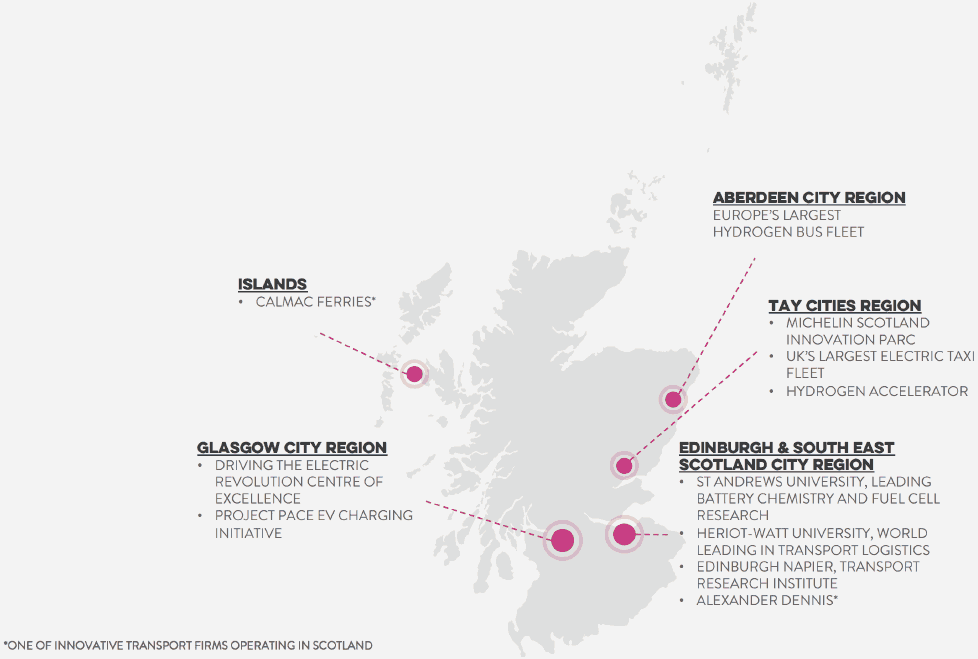
There are a range of ambitious, innovative, low carbon transport projects across Scotland, including:
- The development of the Michelin Scotland Innovation Parc in Dundee, a globally competitive centre for advanced manufacturing, skills and innovation in low carbon energy and sustainable transport;
- The deployment of Europe’s largest hydrogen bus fleet, in Aberdeen;
- The UK’s largest electric taxi fleet, in Dundee;
- The BIG HIT and Surf ’n’ Turf projects in the Orkneys creating integrated approaches to hydrogen in transport and heat networks;
- The deployment of the world’s first hydrogen
dual-fuel refuse collection vehicles in Fife; - Project PACE, a partnership between government and energy network operators on the development and innovative management of electric vehicle charging networks.
A wide range of companies are involved in the transport supply chain covering on and off road vehicles, and the marine, aerospace and rail sectors. Examples include:
- Alexander Dennis Ltd, manufacturer of electric buses and developer of the UK’s first prototype hydrogen fuel cell double deck bus;
- Hillend Engineering, developer of zero emission refuse collection vehicles and other heavy duty applications;
- Logan Energy and Hydrasun, developers of integrated hydrogen fuelling systems;
- Emergency One, developing zero emission vehicles for the emergency services;
- Calmac, the operator of the world’s first diesel-electric hybrid ferries, serving routes around the Clyde and Hebrides;
Scotland’s universities and research centres are home to considerable expertise in transport, mobility and related sectors. These include:
- The Driving the Electric Revolution centre of excellence at the University of Strathclyde, linked to the Power Networks Demonstration Centre and the National Manufacturing Institute for Scotland;
- The Hydrogen Accelerator, based at St Andrews University and involving institutions across Scotland to provide expert advice and support the development and deployment of hydrogen-related transport projects;
- St Andrews University, a leading player in research into battery chemistry and fuel cells;
- Heriot-Watt University, world leading in transport logistics;
- Edinburgh Napier University, a hub for deployment of Ultra Low Emission Vehicles, including the Transport Research Institute.
Collaboration between industry and education is shaping the curriculum and talent pipeline in areas such as:
- Electric Vehicles and High Voltage Safety Training;
- Hydrogen powered transport;
- Rail.
This pipeline is being strengthened by the transition of skilled workers from the Oil and Gas industry applying their skills in the low carbon sector. This is all underpinned by The Climate Emergency Skills Action Plan which will enhance the availability of the right skilled talent in Scotland.
Scotland’s National Transport Strategy (NTS) embraces innovation and technological advances and provides a framework for them to be used to Scotland’s benefit: to create more sustainable modes; to provide greater and equal opportunities for disadvantaged groups; and increase the efficiency and safety of the transport system. The Strategy recognises that we need to ensure Scotland is at the forefront of growth in ULEV markets; that there is a fair distribution of investment costs that benefit all consumers; and the Scottish businesses capitalise and gain from new market and technological opportunities.
The NTS sets out that we all have a responsibility for realising the ambitions set out in the Strategy, and we are committed to working with stakeholders to develop and implement the delivery of the NTS and the actions set out in this plan.
Scotland’s universities and research centres are home to considerable expertise in transport, mobility and related sectors
Opportunity Area 3: Software & IT
Scotland has over 9,400 digital technology companies engaged in a variety of activities from software development and IT services to digital agencies, games development and telecommunications. Scotland’s dynamic software sector provides products and services across a wide range of end markets from public services through sectors such as banking and insurance to renewable energy and space. In terms of inward investment deal flow in Software and IT, Scotland has attracted 1.3% of the total projects that came into Europe and 1.4% of the jobs, representing 30% and 40% respectively higher than population share over the last three years.
Scotland has a network of business support for the sector, including:
- ScotlandIS: the membership and cluster management organisation for Scotland’s digital technology industry.
- CodeBase Digital Tech Hub, Edinburgh: the largest technology incubator in the UK which provides affordable office space, services and networking.
- Creative Clyde, Glasgow: A flourishing riverside community for media, technology and creative businesses that already counts BBC Scotland, STV, BIP Solutions and Film City Scotland as its residents.
- Techcube, Edinburgh: An integral part of Edinburgh’s tech start-up success story. It creates a collaborative business hub environment.
- Seabraes Zone, Dundee: Provides flexible, commercial space for digital tech companies, building on Dundee’s success as a digital media and creative industries hub.
The digital revolution is impacting all sectors across Scotland as increasing types of businesses are harnessing the benefits of technology to drive innovation and increase competitiveness.[68] Already around 100,000 people are employed in digital technology roles across all sectors and there is a steady stream of high-quality graduates creating a vibrant market with the specialist talent for continued growth.
Two emerging sectors with great potential are in Space Tech (covered in more detail below) and GovTech (that is the application of emerging technologies to solve problems in the public sector). GovTech is developing rapidly through the work of Scotland’s public sector tech accelerator Civtech, enhanced by Connecting Scotland and the Digital Nation challenge.
Scotland’s Digital Skills Academy, CodeClan is an industry and public sector initiative with a mission to help bridge the digital skills gap, fast tracking individuals into digital technology roles through a blended delivery model.
ScotlandIS has established a new Diversity and Inclusion group. According to the organisation women make up around 24% of the technology workforce in Scotland, a number which has doubled since 2014. Some degree of acceleration has been under way but further progress must be made to reach gender balance.
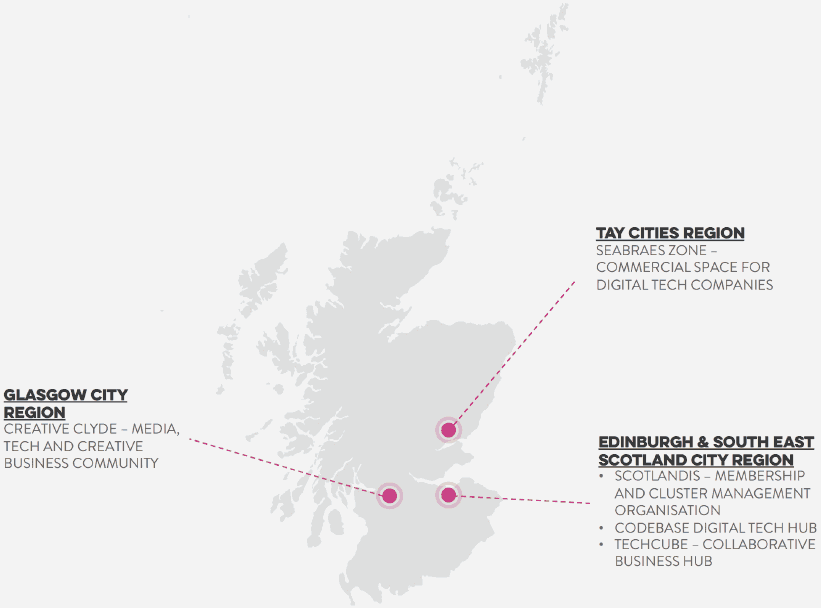
Universities continue to evolve their computing science related courses in line with industry demand, including areas such as ethical hacking, digital health and fintech. Similarly, work based learning opportunities continue to develop and grow across the full breadth of digital skills and across all business sectors.
Opportunity Area 4: Digital Financial Services
The global market for Financial Services is estimated to be worth $26tn, with an emerging Fintech market of around $40bn and projected to grow.
Scotland is a highly competitive location. In terms of inward investment deal flow in Financial Services, Scotland has attracted 1.5% of the total projects that came into Europe and 0.7% of the jobs, over the last three years.
Scotland is one of Europe’s leading financial centres and the second largest international financial hub in the UK, after London. There are 88,000 people employed in Financial Services in Scotland, across banking, capital markets, asset management and servicing, pensions and investment and insurance.
Fintech is the innovative application of new technology and data to transform how financial services and products are delivered to customers and businesses and improving the way people and businesses purchase, access and manage their finances. Fintech is being applied ‘horizontally’ across the economy and is not confined to one economic sector. It involves a range of technologies and data tools applied across business services, retail, government services, regulatory controls etc.
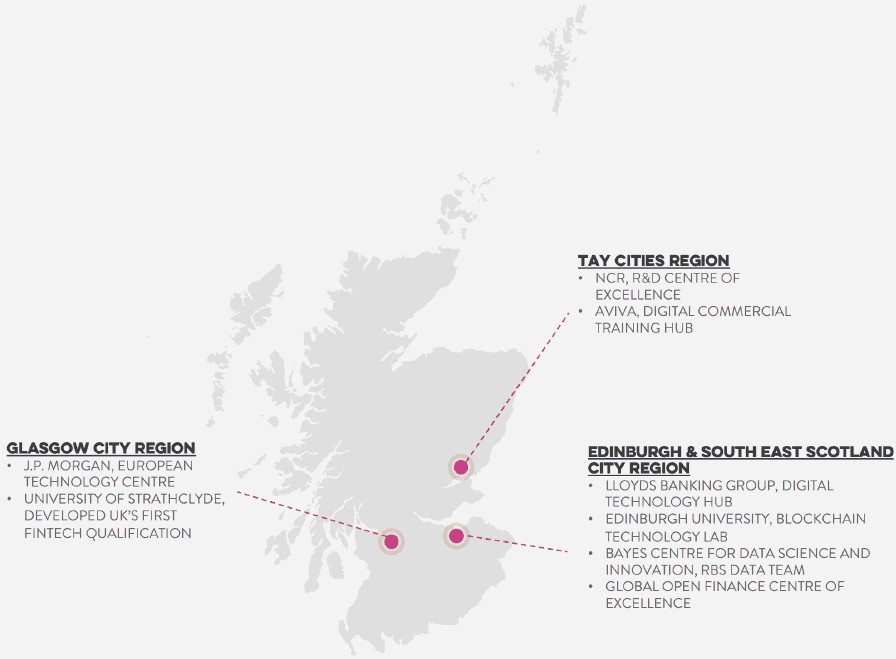
The application of fintech provides opportunities to develop new business models, create new businesses, generate jobs, increase efficiencies, improve productivity and deliver better inclusive social outcomes for people.
Through its innovative and collaborative model, FinTech Scotland has led Scotland to be recognised as the UK’s first fintech cluster centre of excellence by the European Economic Cluster accreditation body and one of only three in Europe. This cluster excellence has been further reinforced by the establishment of the world’s first Global Open Finance Centre of Excellence by FinTech Scotland in collaboration with the University of Edinburgh and various other major bodies and institutions.
The combination of a strong, mature financial services sector and vibrant globally recognised fintech cluster is what gives Scotland its edge
Fintech start-up and scale-up enterprises include the globally renowned FNZ, which partners with major financial institutions to enable them to provide multi-channel wealth management services to their clients, and Nucleus Financial, advising life companies and fund managers on new models for pensions and investment products. The adviser platform, which has £14.3bn of assets under administration and more than 90,000 customers, floated on London’s Alternative Investment Market in 2018. Further examples are Money Dashboard, an online personal financial management service with 100,000 UK users and Previse, an AI instant payment solutions and a European top 50 fintech business.
Some of the UK’s largest financial firms are headquartered in Scotland, including RBS, TSB, Standard Life Aberdeen and Baillie Gifford. Scotland is strategically valued by a range of successful global financial service companies including Morgan Stanley, Aviva, BlackRock, Citi and State Street. HSBC selected Scotland to establish a UK centre of excellence for its global risk and compliance operations. Barclays is developing a new campus in Glasgow for the bank’s technology and operations teams, creating 2,500 new jobs.
Scotland has several major technology development centres for global Financial Services companies:
- JP Morgan has its European Technology Centre in Glasgow, working on areas like machine learning, cybersecurity, big data and mobile payments
- NCR has its R&D Centre of Excellence in Dundee, developing next generation ATMs
- Aviva created its Commercial Digital Training Hub in Perth to bring together its online and traditional brokering teams and maximise financial technology benefits
- Lloyds Banking Group has invested in a Digital Technology Hub in Edinburgh
This combination of a strong, mature financial services sector and vibrant globally recognised fintech cluster is what gives Scotland its edge.
Scotland has a strong mix of technology and financial expertise and a highly skilled workforce. Nine universities across Scotland provide more than 50 specialised banking, finance and risk management courses and 8,500 students study finance and accounting in Scotland’s universities each year.
Work Based Learning opportunities and Apprenticeships in financial services are increasingly popular and companies like Barclays, Morgan Stanley and Standard Life Aberdeen are already seeing the benefits of employing apprentices.
Fast Track is an award-winning work-readiness course, developed for those keen to launch a career in financial services. It is co-designed and co-delivered by industry and colleges working in collaboration and supports new entrants with the mix of skills needed for the sector: financial and customer services and technical and meta skills.
Scotland also has relevant world class research strengths that attract global talent including Data Sciences, Informatics, Artificial Intelligence and Blockchain:
- Edinburgh University School of Informatics is the largest in Europe and is ranked first in the UK for research power. It has a Blockchain Technology Lab within the School of Informatics.
- Several Scottish universities have expertise in Artificial Intelligence including Glasgow, Aberdeen and St Andrews.
- RBS has located a data team within Edinburgh University’s new Bayes Centre for Data Science and Innovation
- The University of Strathclyde developed the UK’s first Fintech qualification and fintech courses are now delivered by six Scottish universities.
Fintech Scotland is developing this cluster by linking emerging fintech enterprises technology firms, large Financial Services firms and universities to achieve critical mass and ensure Scotland has the foresight and flexibility to embrace market developments, for example in open finance, financial inclusion, payments, capital markets and regulation adapt to changes in the market, such as Open Finance.
Scotland aims to position itself as a Global Open Finance Centre of Excellence, demonstrating how it can support sustainable, inclusive growth that delivers social and economic benefits.
Opportunity Area 5: Digital Business Services
The Global Business Services market was worth $211 billion in 2019.
Global Business Services (GBS) includes outsource service providers and in-house shared service centres which provide a range of services to customers. Typically, these include customer services, finance and accounting, human resources, payroll, legal services, industry specific services and technology support and development.
The sector has been experiencing a period of significant change in services delivered, operating models and digital transformation due to technological, economic and political factors.
Scotland is a very competitive location. In terms of inward investment deal flow in GBS, Scotland has attracted 2.2% of the total projects that came into Europe and 3.4% of the jobs, over the last three years.
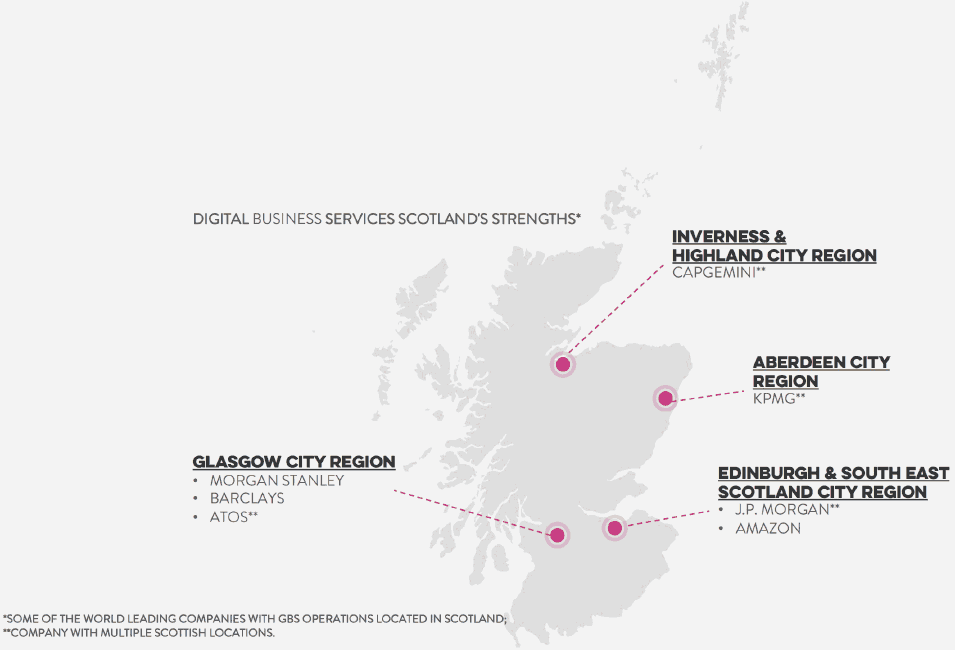
Scotland has a compelling proposition for the delivery of these services, and we have witnessed the sector transform from the delivery of transactional services to more complex and higher value services. The main reasons for companies choosing Scotland as a delivery location include: access to a talented workforce with over 150,000 people employed across the sector; a competitive cost base; and world-class infrastructure and connectivity.
This opportunity area makes a significant contribution to Scotland’s inward investment success with around 30% of all fDi coming from GBS over the last decade. World leading companies that have located GBS operations here include Sky plc, Amazon, KPMG, Barclays, JP Morgan, Morgan Stanley, Capgemini, Cigna and Tesco plc.
As the opportunity area continues to adapt and transform at pace there are opportunities for Scotland to attract more higher value operations. Not only more complex customer services and business services functions which are more important for businesses than ever, but also centres of excellence in areas including: Artificial Intelligence; Blockchain; Cyber; and emerging digital technologies such as Augmented Reality.
Companies delivering GBS can access Scotland’s Apprenticeship programme to attract new talent into their business and as a route to upskilling and reskilling their existing workforce. Key elements of this programme include:
- Foundation Apprenticeships in Business Skills
- Modern Apprenticeships in Business and Customer Services
- Masters Level in Graduate Apprenticeships in Business Management
Opportunity Area 6: Space
The global space market is estimated to be worth £400bn by 2030. The Scottish Government’s ambition is for Scotland to become the first country in Europe to provide an end-to-end solution for small satellite manufacture, launch and innovation in satellite data analysis. Scotland is already ‘punching above its weight’ with 133 companies operating in the space sector in Scotland employing 8,000 people (19% of the UK total).
More small satellites are being designed and built in Glasgow than any other city in Europe by companies such as Spire, AAC Clyde Space and Alba Orbital. Rocket manufacturers and launch operators, like Skyrora and Orbex, have already chosen Scotland as a location to invest and there will be opportunities in developing the launch supply chain. Satellite data and its applications are accelerating, creating opportunities for Scotland’s data analysis companies such as Ecometrica, Global Surface Intelligence, Bird.i and Astrostat.
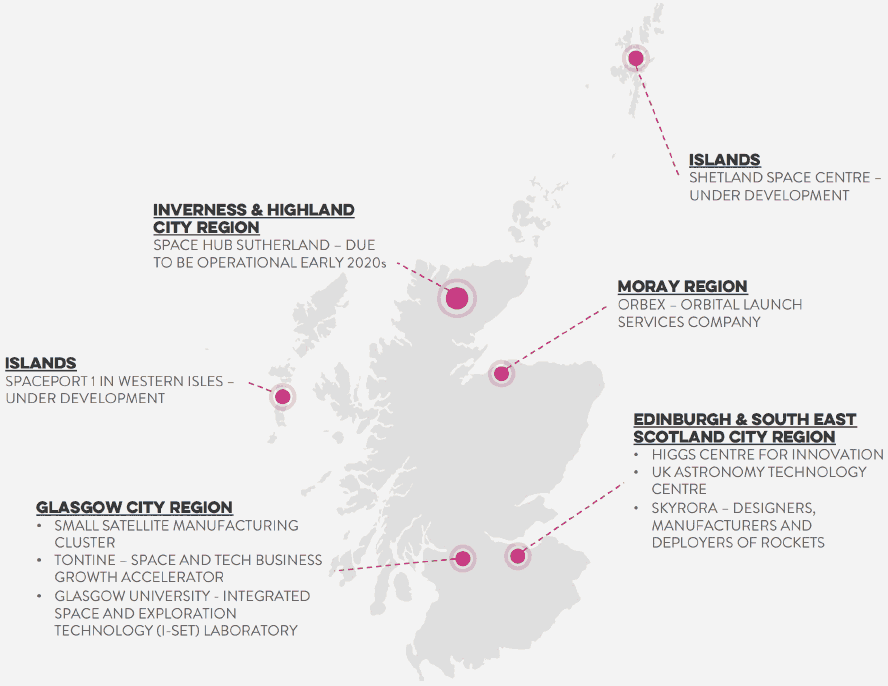
The UK Astronomy Technology Centre in Edinburgh is the centre for expertise in this field and is currently developing the replacement Hubble telescope. Edinburgh is also home to the Higgs Centre for Innovation: a business incubator to support start-ups and SMEs in the satellite, space and data-intensive sectors. The University of Glasgow’s Integrated Space and Exploration Technology (I-SET) laboratory opened mid-last year and works focuses on exploration technologies and spaceflight hardware. The laboratory provides researchers with hi-tech facilities and ground-breaking devices, such as a Helmholtz cage simulating Earth’s magnetic field in orbit. Tontine in Glasgow is a growth accelerator for innovative space and technology businesses.
Scotland is naturally well suited to support launch activities and has unique geographic advantages such as remote location, close to the sea and in the northern half of the northern hemisphere. This means Scotland is ideally located to reach attractive polar and sun synchronous orbits which currently account for 95% of future orbital requirements, including earth observation activity. There are currently five commercial spaceports being developed in Scotland including 3 vertical launch sites: Space Hub Sutherland, Shetland Space Centre and Spaceport1 in the Western Isles, and two horizontal launch sites at Glasgow Prestwick Airport and Machrihanish. All of the spaceport developments are progressing at speed, with Space Hub Sutherland, in the Scottish Highlands, the most advanced as it aims to be the UK’s first vertical launch site and is due to be operational early in this new decade.
The Scottish Government is fully committed to tackling climate change and within Scotland there is high alignment between the overarching policy goals of net-zero and the core products and key skills of the sector
Scotland continues to attract and develop the highly skilled workforce needed to grow this high-tech, research and development led sector and to ensure the skills and education systems are fully engaged in supporting this growth. The Scottish Government is working in partnership with industry through the Scottish Space Leadership Council (SSLC) to raise the profile of Scotland as the home of ‘agile space’. Our collective aim is to become a leading global destination for those wishing to access space and space services or to locate or establish their businesses in an environment supportive of the growth and success of industrial space businesses.
The Scottish Government is fully committed to tackling climate change and within Scotland there is high alignment between the overarching policy goals of net-zero and the core products and key skills of the sector. There are enormous societal and economic opportunities and we aim to ensure that the environmental impact of space activity does not come at a greater cost than the corresponding benefits. Our rocket manufacturers have made significant developments to support the reduction in the environmental signature of their vehicles. Through a mixture of innovative fuels, smart designs, advanced materials and manufacturing techniques, they aim to dramatically reduce the carbon footprint associated with launch. Furthermore space data is set to be at the very heart of tackling the major issues facing our society, with satellite data currently used to monitor 35 of the 45 essential climate variables defined by the UN. Scotland has leading expertise in the collection, analysis and utilisation of data for Earth Observation (EO) that can play a critical role in the transition to a net-zero economy. We want Scotland to be a leading nation in addressing global climate change and through designing, manufacturing, launching and analysing satellites and satellite data we will be.
Opportunity Area 7: Healthtech
Healthtech describes the range of products and services that integrate digital health technology, data capture & analysis, sensors and AI, to create personalised health solutions for this rapidly expanding market, estimated to be worth $150bn globally.
Innovations in health technologies and models of healthcare will enable more people to monitor and manage their health and wellbeing at home and remain independent. They will increase efficiencies and reduce costs in healthcare systems, improve quality of care, particularly in remote and rural areas, and tailor health services and precision medicine to match the needs of individual patients.
As well as creating new products and services, Healthtech has the capacity to upgrade existing products and technologies widely used in the NHS to accelerate care delivery and enable clinical staff to make faster decisions at point of care.
Examples of this include Capsule Endoscopy (via NHS ScotCap) programme, using miniature cameras ingested by patients. These link to existing NHS technologies to help improve diagnosis and early intervention in colon cancer.
Scotland’s approach to the sector is characterised by ‘The Triple Helix’ which is based on strong collaboration between the NHS, industry, academia. The strong collaborative spirit in Scotland is an asset which attracts and anchors businesses in Scotland.
Not only making a vital contribution to the economy, this collaborative approach and ground-breaking innovation underpinned the recent sector response to Covid-19. As highlighted in a recent publication[69], Scotland’s life science sector has been heavily involved in the global Covid-19 response, contributing across the test supply chain, vaccine development and associated supply chain as well as therapeutics.
Scotland has a long history of innovation in healthcare and the NHS in Scotland has a clear focus to foster innovation, in particular from Scottish based businesses, and to support its adoption within the health service. There is a strong ecosystem to support that, including:
- The Health Innovation Assessment Portal (HIAP) allows companies to register innovations and receive feedback from suitably experienced and qualified stakeholders across NHSScotland.
- The Scottish Health Technologies Group (within NHS Health Improvement Scotland) evaluates the properties and effects of innovative non-medicine health technologies and to provide manufacturers
- and others with opportunities to submit innovations for assessment within NHSS.
- Scottish Health Innovations Ltd (SHIL) was set up by the Scottish Government to encourage innovation from our clinicians to build on the world-class research for which Scotland is renowned. Some of the world’s most important drug discoveries have been made by Scots - salbutamol to relieve asthma attacks, beta blockers used to treat heart conditions and the world’s first artificial vaccine against hepatitis B infection, to name a few. Medical techniques and devices including ultrasound scanning and MRI were also developed in Scotland.
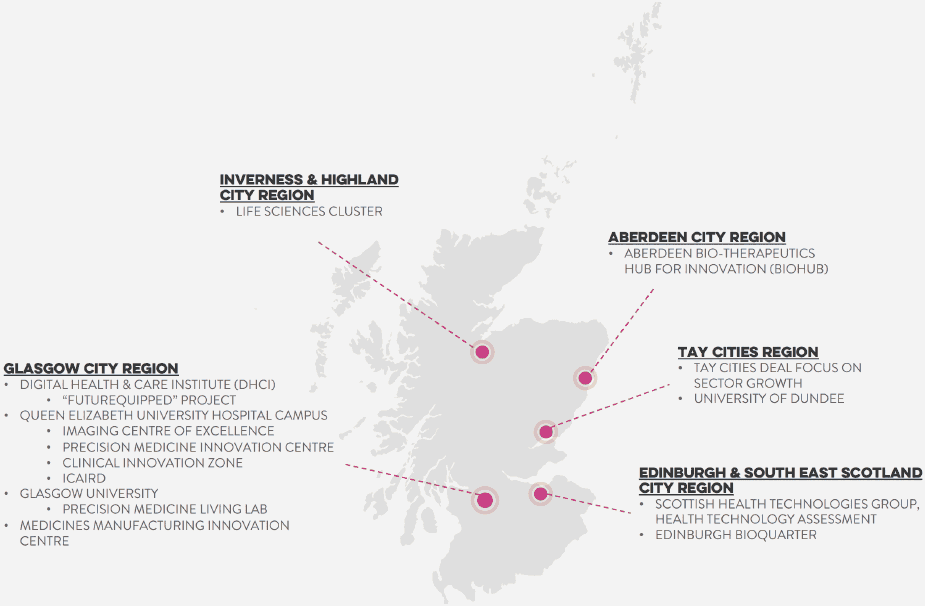
- To develop industry partnerships the Scottish Government funds test beds to develop innovations able to provide real-word evidence to improve patient outcomes at the same or less cost than current practice.
- The Bio-therapeutics Hub for Innovation (BioHub) on Aberdeen’s Foresterhill Health Campus will provide physical infrastructure and support programmes to grow businesses, nurture new commercialisation opportunities, and connect life sciences academics and health researchers to industry. It is intended to build on the existing life sciences cluster in the north east of Scotland, and is scheduled to open to tenants in 2022.
- The BioHub will bring together the triple helix of academics, clinicians and commercial organisations offering space for collaboration and networking, in order to develop the next generation of medicinal therapies and products.
- The BioHub has received investment through the Aberdeen City Region Deal, a partnership between the Scottish and UK Governments, Aberdeen Council, Aberdeenshire Council and private sector-led economic development body Opportunity North East (ONE).
In addition, Scotland already has a rich talent pool in key areas of digital health innovation, data analytics, AI and sensors. More than 7,000 people work in healthtech companies across Scotland and there is a pipeline of 17,000 graduates each year with digital health expertise.
There around 150 businesses operating in healthtech in Scotland from innovative homegrown firms like AxSys Technology, Aridhia, ODx Innovations, Nugensis, MIME Technologies, Aseptium, Gaeltec and Sitekit, to large multinationals such as Lifescan, Canon Medical Research Europe Ltd, Selex and Lockheed Martin. ODx Innovations recently chose Scotland ahead of Ireland, other sites in UK, EU and US as representing the most attractive mix of cost, availability of skills and clinical partnerships. This has allowed them to increase employment from 1 to circa 90 staff within 18 months.
Scotland is at the forefront of healthtech innovation:
The Digital Health and Care Institute (DHCI) connects industry, universities, NHS, social care and government, making it easy for companies to develop and test near-market solutions in a range of health and care environments.
NHS24, Scotland’s national digital health and care provider, develops and tests new products and services through its Scottish Centre for Telehealth and Telecare
Scottish Health Technologies Group (SHTG) and work on Health Technology Assessment (HTA)
The Farr Institute of Health Informatics Research uses Scotland’s high-quality electronic healthcare datasets to help develop new medicines and improve healthcare services.
The Edinburgh BioQuarter is a leading global destination for healthcare delivery, ground-breaking medical research and life sciences innovation and entrepreneurship. The site boasts a major acute teaching hospital, a world-renowned school of medicine and a host of ambitious life sciences companies.
Precision medicine enables clinicians to match medical treatments to the individual characteristics of each patient, based on an increasingly data-driven approach to healthcare. Scotland is a highly competitive global player in this emerging field through a combination of:
- significant investments in major clinical and research assets;
- world class clinical research and a highly skilled workforce;
- high quality electronic health records.
Scotland has world class clinical and research assets that industry can access.
Major investments have been made at the £1bn Queen Elizabeth University Hospital (QEUH) campus in Glasgow, making it the first clinical-academic industry campus worldwide designed around the clinical implementation of precision medicine.
These assets include
- The Imaging Centre of Excellence, equipped with ultra-high-performance MRI scanners for research and clinical applications.
- Precision Medicine Scotland Innovation Centre.
- A Clinical Innovation Zone to foster open innovation and collaboration between world-leading clinical academics and co-located industry partners.
Scotland’s key role in the sector has been recognised with The University of Glasgow being awarded £38m to create the Precision Medicine Living Lab, an internationally leading project focused on translating cutting-edge science and innovation into a real world clinical setting, and the decision to base the UK-wide Medicines Manufacturing Innovation Centre in Renfrewshire. MMIC is working to develop the new generation of manufacturing processes for the pharmaceutical and fine chemical industries.
Scotland has world class clinical and research assets that industry can access
Inverness Campus brings together commercial companies, NHS Highland via Raigmore Hospital and the new elective care centre, with UHI as part of a £100m investment to grow and sustain skills and companies in the Highlands.
Scotland has a growing number of companies involved in precision medicine, including: Canon Medical Systems; Simens Healthineers; MR Coil Tech; Spiritus; Aridhia; Causeway Therapeutics; Fios Genomics; Pharmatics; Sistemic; Destina Genomics, ReproCELL Europe; BioClavis; ThermoFisher Scientific and Arrayjet.
The Industrial Centre for Artificial Intelligence Research in Digital Diagnostics (iCAIRD) brings together a pan-Scotland collaboration of 15 partners from across industry, the NHS, and academia.
To support the growth of the sector in Scotland, industry and education have jointly developed a range of apprenticeship programmes in Health & Social Care, Data Science, Software Development and Science & Technologies. Uptake of these sector specific frameworks are increasing year on year.
Scotland has a long history of innovation in healthcare and the NHS in Scotland has a clear focus to foster innovation, in particular from Scottish based businesses, and to support its adoption within the health service
Other notable centres include:
DHCI flagship Smart Housing project (FUTUREquipped) is working with 13 colleges across Scotland to pool knowledge and expertise in healthtech, sensors, augmented and virtual reality and advanced construction technologies to ensure participants are aware of the latest developments in these sectors: https://youtu.be/9XxwoY2Dw7I.
NHS Greater Glasgow & Clyde Medical Devices Unit (MDU) is specialist team providing medical technology development capabilities and a gateway to enable collaboration with industry and academia, offering imaging, mechanical, electronic and low-level software design and development capabilities.
Strathclyde Universities Medical Devices Unit, offers research brokering, spin-in and spin-out information, support and advice for clinicians and clinical staff with research needs (including advice on postgraduate study or research in Medical Devices) and information on our current pre-commercial project portfolio. In addition the Institute retains close links with the medical technology industry in Scotland and the rest of the UK and actively encourages contact from SMEs as well as established medical companies.
Opportunity Area 8: Transformation of Chemical Industries
Scotland’s chemicals sector manufactures bulk chemicals, such as petrochemicals and fertilisers, as well as fine and speciality chemicals, such as food flavours, fragrances, pigments and pesticides.
Scotland is a key location for investment. In terms of inward investment deal flow in the Chemicals sector, Scotland has attracted 1.2% of the total projects that came into Europe and 3% of the jobs, over the last three years.
Industrial Biotechnology is an emerging, clean technology which can support the transition of these petrochemical based industries to sustainable manufacturing, producing many of these products from renewable feedstocks, including CO2 through Carbon Capture and Utilisation (CCU), and innovative biological processes.
The global market for Industrial Biotechnology is projected to reach $577bn by 2026.
Scotland’s competitive edge in Chemicals and Industrial Biotech is based on:
- A highly qualified talent pool of 1,000 graduates in chemistry, or related subjects, each year and 10,000 skilled staff already working in the sector.
- Research excellence: According to Scottish Economic Statistics published by Scottish Enterprise in February 2020, Scotland’s chemical sciences research base is consistently ranked top three in the world.
- Innovation assets such as:
- CMAC, based at the University of Strathclyde, which conducts world class research in Continuous Manufacturing and Advanced Crystallisation helping global pharma companies revolutionise the way they make pharmaceuticals and high value products;
- IBioIC: The Industrial Biotechnology Innovation Centre in Glasgow, which connects industry with research expertise to accelerate the development of new biotechnology processes and products for the global market;
- Heriot Watt University, which is the lead for the UK Decarbonisation Research and Innovation Centre, specialising in CCU technologies.
Built assets include Grangemouth: Scotland’s largest industrial site and home to Scotland’s largest port.
This site is currently responsible for 40 percent of the Scottish manufacturing sector’s total CO2 emissions.
Scotland’s vision for Industrial Biotechnology is built on transforming this major petrochemical industrial site at Grangemouth into a hub for sustainable high value manufacturing that can help move the industry towards net zero emissions. The first steps in this journey are the development of new industrial biotechnology pilot plant and demonstrator facilities on-site to test CO2 re-use and biomass as feedstocks, and create new, clean biorefinery processes.
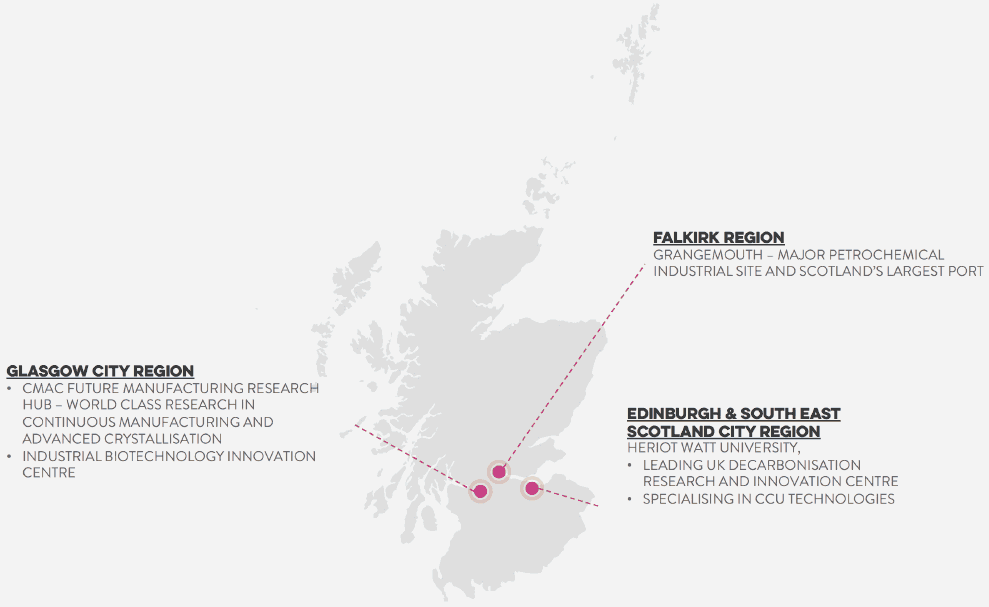
There are 150 Chemicals companies across Scotland employing over 10,000 people. Businesses include: Ineos, FujiFilm, DSM, GlaxoSmithKline, DuPont Teijin Films and Syngenta. There are 120 companies in Industrial Biotechnology, such as: Celtic Renewables; CelluComp; AMT; Horizon Proteins; Ingenza; Glycomar; and Cuantec.
Key skills initiatives within the sector include:
- Working in partnership, industry, education and enterprise agencies have developed The Life & Chemical Science Workforce Development tool, https://skills.directories.scot/ It helps all parties identify availability of the workforce across Scotland on a regional and Scotland-wide basis and identify and source skills provision to match individual needs.
- Scotland continues to develop its skills and training provision to meet the increasing demand for jobs within Life & Chemical Sciences, particularly in Engineering, Digital and Quality & Regulatory roles.
Scotland has attracted 1.2% of the total projects that came into Europe and 3% of the jobs, over the last three years in the Chemicals sector
Opportunity Area 9: Food and Drink Innovation
Innovation in Scotland’s Food and Drink sector can help it tackle global challenges by, for example:
- Creating healthier food and drink products;
- Developing food production systems, particularly for the agriculture sector, that will help the industry achieve net zero emissions targets by 2045 and protect and restore the natural environment;
- Introducing advanced manufacturing technologies that improve productivity and sustainability.
Innovative companies include: Intelligent Growth Solutions which has created highly sophisticated technology for indoor vertical farming which enables efficient production of food in any location around the world; and Soil Essentials who use data from satellites, drones and weather models to improve sustainable farming techniques, crop output and productivity across the sector.
Food and drink is a leading sector of Scotland’s economy, with £15 billion in annual sales, including over £6 billion in international exports across a very diverse range of products
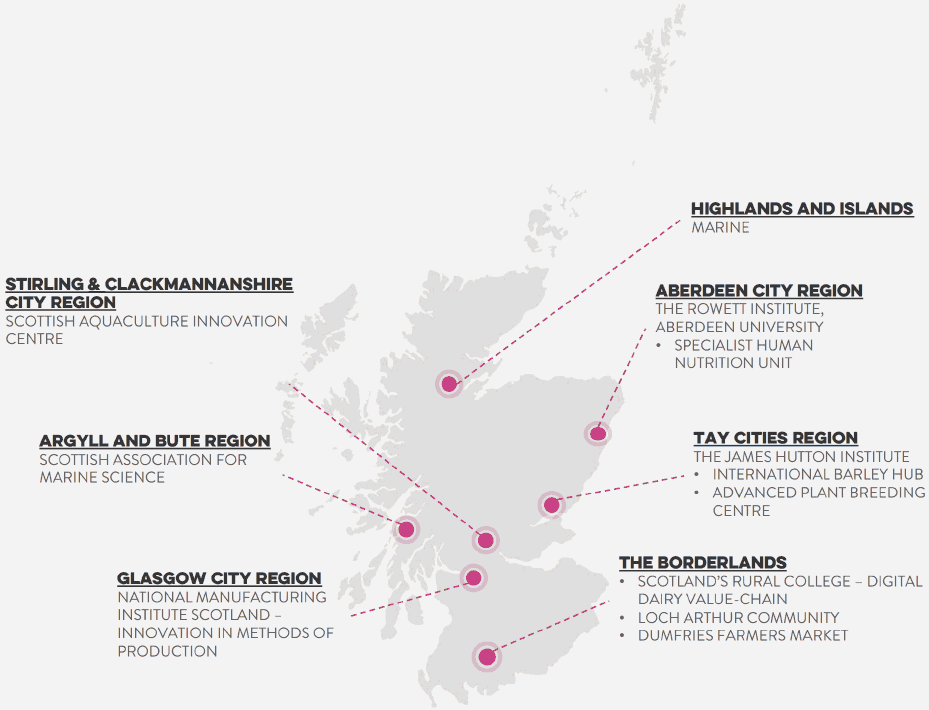
Aquaculture is a good example of an established sector that can use innovation to tackle these challenges. The sector generates 2,000 direct jobs and its supply chain supports a further 10,000 jobs, offering opportunities in some of Scotland’s most remote and fragile communities. Scotland is one of a limited number of countries that can farm premium Atlantic salmon healthily and cost-effectively.
The iconic Scotch whisky industry is at the forefront of Scotland’s sustainable growth ambitions with pathways to achieve net zero by exploring new technologies, focusing on water stewardship responsibilities, building circular economy supply chain collaborations and by developing ‘net zero cereals’ together with farmers, maltsters and the International Barley Hub.
The iconic Scotch whisky industry is at the forefront of Scotland’s sustainable growth ambitions with pathways to achieve net zero by exploring new technologies
The South of Scotland by its very nature of rurality and geography has a wide offering which is bespoke and responds to the potential of this area as demonstrated through the Local Authorities inclusive and active approach in promoting and capitalising benefits for the area. Dumfries and Galloway Council a has Food and Drink Strategy[70] as well as championing their own initiatives including Naturally DG[71].
Food and drink is a leading sector of Scotland’s economy, with £15 billion in annual sales, including over £6 billion in international exports across a very diverse range of products. The sector is marked by significant international investment already, particularly across the aquaculture and dairy industries.
Scotland has key Food & Drink research and innovation assets including:
- The Rowett Institute at Aberdeen University, which is a global leader in nutrition research. Its specialist Human Nutrition Unit conducts controlled volunteer trials that help companies develop healthier food and drink products.
- The James Hutton Institute, which combines strengths in crops, soils and land use and environmental research. The Institute makes a major contribution to understanding the issues of food production, agritech and environmental sustainability. These capabilities will be strengthened by investments from the Tay Cities Region Deal in the International Barley Hub and Advanced Plant Breeding Centre at the Invergowrie site.
- Scottish Aquaculture Innovation Centre, which connects industry and research to tackle the key issues facing the sector, including the health and welfare of farmed fish, applications of technology to improve productivity and ways to minimise the environmental impact of fish farming.
- Scottish Association for Marine Science (SAMS) in Oban is the oldest marine research organisation in the United Kingdom. Researchers use ingenuity in observing, understanding and predicting the changes in our ocean to develop new solutions to the problems of climate change, depletion of marine life, water pollution, waste, and food security to develop environmentally advanced innovation and commercialisation products to benefit the blue economy.
- Loch Arthur Community https://locharthur.org.uk/offers ‘Opportunities for Young People and Adults with additional needs in food manufacturer’. This working community in the South West of Scotland includes men and women with learning disabilities to have a living and working experience around growing and producing food and drink not only for the community but for purchase nationally. This is undertaken using sustainable methods with a focus on health and wellbeing - not only in their own community but the wider community that they sit within. A commercially viable model of production, sales and hospitality has been created around it and their products (specialism in cheese production) is now exported Internationally.
- Dumfries Farmers Market (DFM) www.dumfriesfarmersmarket.co.uk offer a Food and Drink Incubation Model which supports and creates pathways and opportunities for incubation of food and drink innovation and developing viable business models and where ideas can be nurtured and developed into viable businesses. DFM has developed an online model during this time of Covid lockdown and is currently developing a business case of a sustainable central distribution and transport model to further grow the businesses.
- A digital dairy project led by Scotland’s Rural College (SRUC) was awarded £50,000 in seed-corn funding by UK Research and Innovation. The project will produce a detailed Strength in Places application aimed at establishing South-West Scotland and Cumbria as the leading region for advanced, sustainable and high-value dairy processing. The project will help create a more efficient and resilient dairy industry. By using digital twinning, combining digital communications and advanced manufacturing, it will enable the tracing of milk, cheese and other products and provide assurance to retailers, wholesalers and consumers.
The Food and Drink industry continues to explore new and innovative methods of production, collaborating with leading universities
The Food and Drink industry continues to explore new and innovative methods of production, collaborating with leading universities, engaging in developments through NMIS and ensuring vocational qualifications are fit for purpose for this fast-evolving sector.
In addition there are significant collaborative structures between the industry and public sector in Scotland, who are working jointly to double the value of the sector to £30 billion by 2030. As a result Scotland’s international reputation for food and drink continues to strengthen.
Scotland offers a full range of skills provision, from Foundation Apprenticeships through to degree and postgraduate level qualifications, with high quality skills provision emerging from universities such as Robert Gordon University, Abertay University and Glasgow Caledonian University.
The nine opportunity areas outlined deliver a mix of wider benefits to the economy
6.6. Delivering Wider Economic Benefits
The nine opportunity areas outlined above deliver a mix of wider benefits to the economy. Energy transition and decarbonisation of transport can add high value to local supply chains. Healthtech, digital business services and biotechnology spur innovation. Food and drink innovation drives significant regional impact. All opportunities areas provide high quality jobs with good wages.
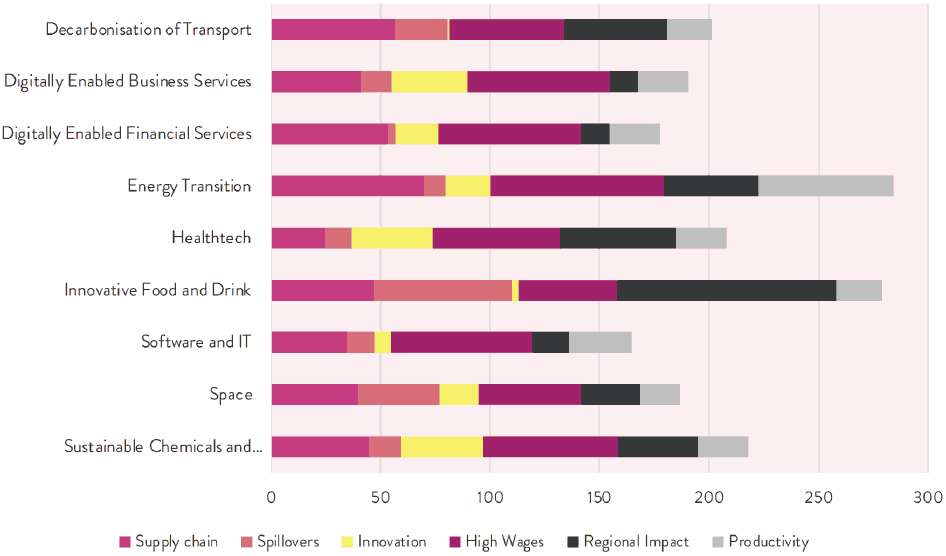
Source: Office of the Chief Economic Adviser Analysis using data from multiple sources. Please see the technical methodology note for more information.
The chart shows the type of spillover benefits that each opportunity area delivers to the wider economy. Through a focus on these sectors, and building clusters attractive to inward investors, we can increase the value of spillover benefits to Scotland’s economy and realise a higher share of the additional job, wages, economic activity and tax revenues identified in Section 3.
6.7 Delivering Wider Economic Benefits Across Scotland’s Regions
Central to our values-led approach is a commitment to ensuring all regions are able to share in Scotland’s economic success. The Scottish Government is clear that the benefits of a growing economy should be felt in all of Scotland’s communities. From an inward investment perspective this means understanding the country’s assets, natural and built, people and skills, that exist across all of Scotland’s regions and being able to promote these in the context of a national prospectus.
Scotland already benefits from a broad spread of inward investment across the country, and this is something this plan seeks to build on. We have already seen from the Chart in section 4 that inward investment jobs are already widely dispersed across Scotland. Glasgow, Edinburgh and Aberdeen all rank in the top 10 UK cities for inward investment projects, with Livingston, Dundee and Falkirk also attracting significant inward investment.[72]
Central to our values-led approach is a commitment to ensuring all regions are able to share in Scotland’s economic success
There is however also considerable advantages in ‘going to market’ with a single, strong, focus on Scotland as the investible proposition. The work that has been done in recent years to coordinate and align Scotland’s cities and regions behind a single set of messages around capital investment propositions – for example at the annual MIPIM event – shows the value of this approach. Viewed from the outside Scotland is not a large geography. Indeed from the perspective of international investors travel distances between the various parts of the country lend themselves to it being thought of as a single entity.
Different regions of Scotland have different assets that can attract different types of inward investment, but on the international stage these offer most value as part of an overall, single Scottish prospectus.
Our challenge therefore is to combine the strong messaging of ‘Scotland as the investible proposition’ – built on our values and coherent focus on the nine opportunities areas - with the ability to showcase and promote our regional strengths that can play on a truly global stage. To work with Scotland’s regions to shape proposals to sell those regional strengths through our platforms as part of an overall, single Scottish prospectus. To promote within that the building of clusters of excellence around place-based assets of international quality.
In Section 4.7 we identified the importance of Scotland’s Regions and some of the key assets they already possess that are central to attracting inward investment, and in Section 5 we detailed the regional strengths as they relate to our nine identified opportunity areas. Here we align this Regional approach with the wider policy agenda, including the importance of Place to the Governments overall policy priorities.
The report of the Advisory Group on Economic Recovery ‘Towards a Robust, Resilient Wellbeing Economy for Scotland[73], published in response to Covid-19, recognises recent reforms, including the 2016 review of the enterprise and skills system, to improve alignment and enhanced coordination in our regional economic development.
Building on these achievements the report recommends that ‘Scotland should pivot to a more regionally focused model in order to address the specific new challenges of economic recovery, This model should be tasked to drive delivery of place-based and regional solutions, especially the City-Region Growth Deals.’
City Region Deals (CRDs) and Regional Growth Deals (RGDs)[74] are agreements between Scottish Government, UK Government and local government designed to bring about long-term strategic approaches to improving regional economies. Such long-term investment plans can have the potential to fundamentally shift local economies, as well as address the regeneration of deprived areas.
Flowing on from CRDs and RGDs Regional Economic Partnerships (REPs) have evolved. These are collaborations between local authorities, the private sector, education and skills providers, our economic agencies and the third sector. REPs represent every community in Scotland and we are working with multiple partners (incl. Convention of Scottish Local Authorities (COSLA), Scottish Local Authorities Economic Development (SLAED), Scottish Futures Trust (SFT), enterprise agencies and the private sector) to facilitate this.
South of Scotland Enterprise (SOSE)[75], the economic and community development agency for the South of Scotland was launched on 1 April 2020. SOSE was established as a centre of opportunity, innovation and growth in recognition of the distinct geographical and sectorial differences and challenges that the South of Scotland faces.
- Action 5: We will ensure that our strategic inward investment efforts align with regional growth plans and with Scotland’s Enterprise Areas, building on the strengths and assets each region in Scotland has to offer to create regional clusters of expertise and secure the benefits from inward investment across Scotland.
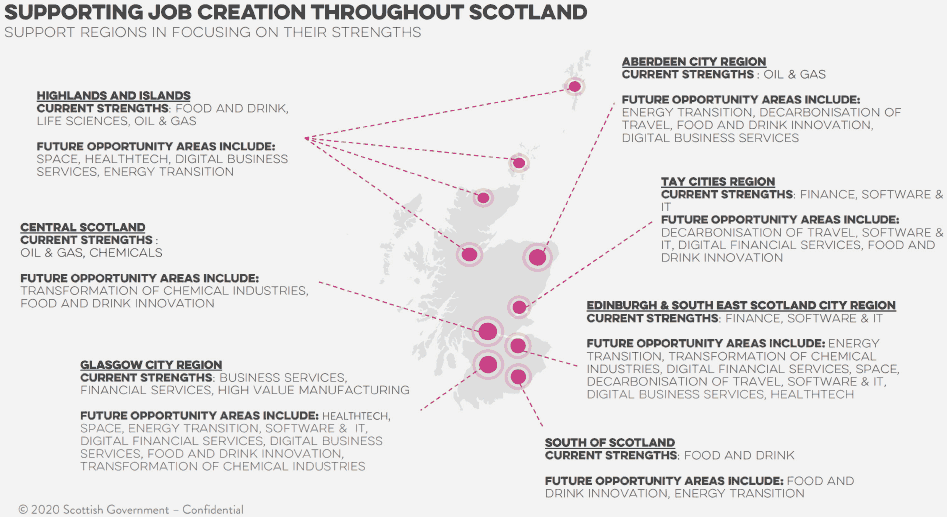
South of Scotland Enterprise was established as a centre of opportunity, innovation and growth in recognition of the distinct geographical and sectorial differences and challenges that the South of Scotland faces
6.8 Leveraging Inward Investment
The focus of this plan is to make Scotland even more successful in attracting inward investors to Scotland, and to maximise the wider ‘spillover’ benefits of that investment to our economy, aligned with our values. As we have recognised, inward investment brings a lot more than money, but the money it does bring – for the establishment of world class facilities, technology, capital equipment, employee recruitment and training is significant, running into hundreds of millions of pounds.
According to fDi Markets, the total inward investment into Scotland in 2019 was $3.92 billon, of which $3.37 billion was in our nine identified Opportunity Areas.
Leveraging that investment is important. Capital outlay by government and agencies to support inward investment can leverage significantly higher investments by the businesses themselves. Successful global businesses, in particular those who align with our values, who are committed to Fair Work and are generating high value jobs value long terms relationship and partnership with the countries they chose to base operations in. Investment by the public sector is often as much a signal of a commitment to that partnership as the value of the money itself.
The value of the benefits to Scotland economy of a successful inward investment strategy has already been highlighted.
Through a combination of facilitation and financial support, Scottish Enterprise/Scottish Development International has historically delivered an average of 6,000-8,000 jobs per annum from new and existing inward investors.
In what is an increasingly competitive global market for inward investment, it is important that Scotland has a strategic and focussed approach to our support. To deliver this more targeted and transparent approach, we will focus resource on strategic investments that shape places and deliver high value jobs, aiming ultimately to allocate approximately £20 million per annum to this work. This will allow us to deliver the existing pipeline of planned inward investment but also to begin development of a portfolio of potential projects and investment which strongly focus on longer term economic aims, including the creation of a low carbon economy, and which seeks to deliver 100,000 jobs over 10 years. We will work with our enterprise partners so that the return on investment is visible and accountable, and seek also to quantify the expected wider spillover benefits to the Scottish economy: boosting exports, supporting R&D and innovation, supporting inclusive growth, strengthening supply chains and building clusters of expertise.
- Action 6: We will focus resource on more strategic investments that shape places and deliver high value jobs, aiming ultimately to allocate approximately £20 million per annum to this work.
- Action 7: We will align with the Scottish National Investment Bank (SNIB) and other sources of capital to support incoming companies to grow.
The focus of this plan is to make Scotland even more successful in attracting inward investors and to maximise the wider ‘spillover’ benefits to our economy
Contact
Email: inwardinvestment@gov.scot
There is a problem
Thanks for your feedback